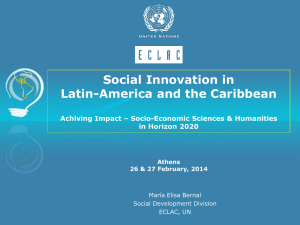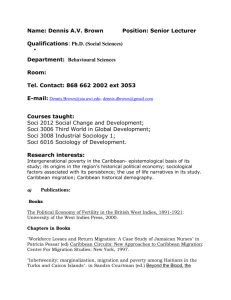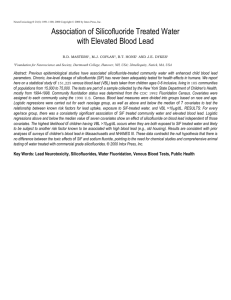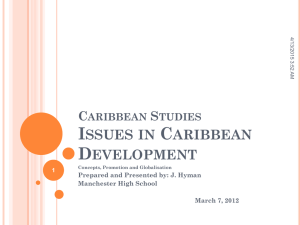(SP) in the Windward Islands (WIs)
advertisement
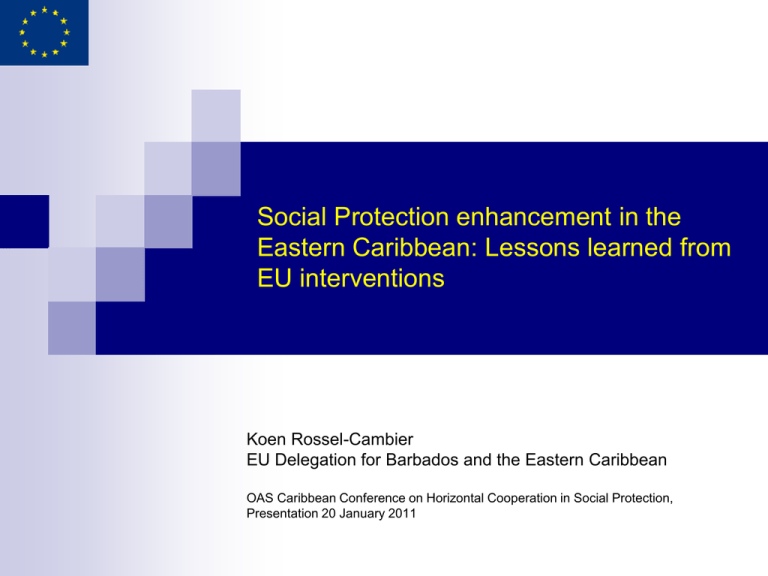
Social Protection enhancement in the Eastern Caribbean: Lessons learned from EU interventions Koen Rossel-Cambier EU Delegation for Barbados and the Eastern Caribbean OAS Caribbean Conference on Horizontal Cooperation in Social Protection, Presentation 20 January 2011 Structure presentation Background EU interventions in social protection The experience of social investment funds in the Eastern Caribbean Lessons learned and ways forward Background EU: 27 countries Various institutions: Council, Parliament, Commission and Agencies, Social Committee and Committee of Regions, Intervention Modalities: European Law and Policies Programmes and funding Collaboration mechanisms EU concerted strategy for modernising social protection Expenditure on social protection accounts for 28.5% of European Union GDP, 63% of this amount is spent on pensions and health care. Its role in the redistribution of income is immense: in absence of social transfer payments almost 40% of households would live in relative poverty, a figure which is reduced through tax and benefit systems to 17%. EU concerted strategy for modernising social protection Promoting social integration “social protection systems should: ensure effective safety nets, consisting of minimum income benefits and accompanying provisions; focus on prevention, fostering active rather than passive measures and providing incentives and pathways to (re)integration into the labour market and society; contribute to a comprehensive and integrated approach to fighting social exclusion, including all relevant policies and players.” EU: A broader concept of social protection Beyond social security, includes most activities linked to prevention of and response to all social deficits; examples: employment generation, training, access to micro-credit and - in a context of high informal economy -microinsurance, access to services to cover basic needs, and other poverty reduction initiatives EU development interventions in social protection The European Consensus on Development clearly indicates employment as a crucial factor to achieve high level of social cohesion. The EC adopted over time a number of key policy documents to address employment, social protection and decent work for all Financing instruments in the period 2007-2013: The European Development Fund (ACP countries), Global Programme “Investing in People” SUGAR and BANANA accompanying measures (SFA) EU MDG support initiative EU initiatives on Social Protection in the Eastern Caribbean Technical support to social protection reform: e.g. SKN, DOM Budget support to PRSP: e.g. Dominica, Grenada Support to vocational training and human resources development (e.g. SLU, BAR) Social Investment Funds The experience of social investment funds in the Eastern Caribbean Social Investment funds: Financing mechanisms that promote/finance public investments in small-scale projects in a variety of sectors identified, and in many cases carried out, by local groups (communities, local governments and NGOs) Eastern Caribbean: Saint Lucia: over 4.5 million euro Saint Vincent and the Grenadines: 4.25 million euro (2006-2008) Dominica: 4.4 million euro (2006-2009) Example: Dominica SIF 25 vulnerable plans and 10 community plans developed 53 projects with each a training component Beneficiaries: 7547 persons and 2300 households 6 vulnerable groups: elderly, children at risk, youth at risk, women, Carib community, physically and mentally challenged 20 communities 591 cases of short term employment 433 persons benefitting from 22 training activities on +management, ECD, proposal writing, leadership, financial management and MandE Good practice from 3 countries Outreach to low-income and vulnerable persons Visibility: internet, TV and press Participatory planning and implementation Community contracting Trickle down of funds for communities Flexibility in implementation Income generating or employment creation spin offs Capacity building Risks and challenges of SIFs Selection of communities Efficiency : start up, recruitment and capacity within project implementation period Overlaps with parallel social funds and mandates of various ministries Sustainability: Project outcomes: maintenance by communities? SIF: dependent on donor funding Political interference Depth but no breadth of poverty outreach Little evidence of decrease of poverty attributed to SIF Transaction costs EU Evaluation of three SIFs Relevance and sustainability of the project outputs and outcomes to the overall SFA framework Efficiency and effectiveness by country of the respective social investment funds Coherence in partnerships created and participatory approach. Commonalities and differences between the three country approaches Recommendations for the design, implementation, monitoring and evaluation of future similar interventions Questions at hand How do SIFs fit into the larger picture of a national social protection framework? Are they suitable to become a long-term tool for community-oriented social protection interventions? Do SIFs alleviate intergenerational poverty and increase social protection? Thank you for your attention







